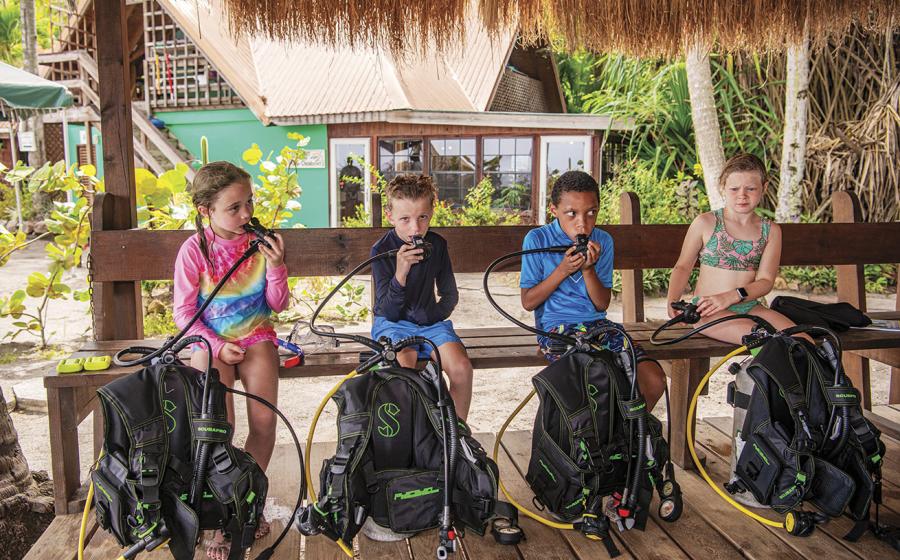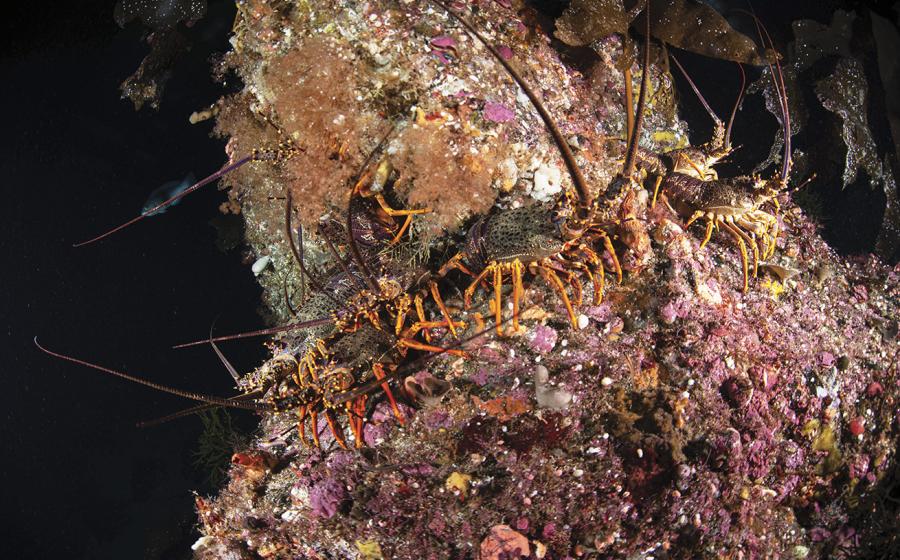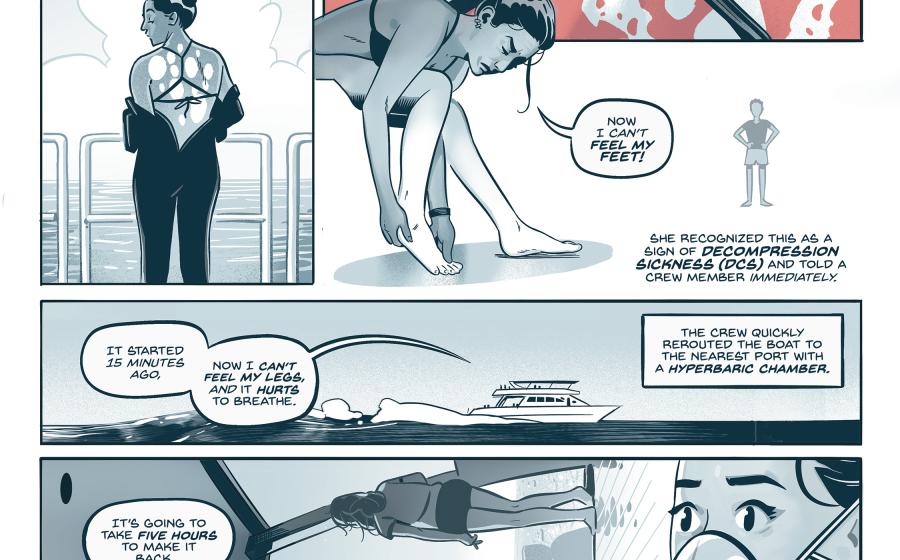Preparing for Your Photo Trip
December 2001
By Stephen Frink
Galapagos Bound
Ed.'s note: These first four questions from Craig Willis, M.D. and underwater shooter, illustrate one of the important tenets of underwater photography: Every destination is unique, requiring you to research and plan for it in order to make the most of your time there.
Which Film?
||
|---|
|  |
|
Q. I've been using a Sea & Sea MMII-EX camera with a YS-60 strobe, a 15mm wide-angle, 1:2 and 1:3 macro lenses, with Fuji Sensia ISO 100 film. Now I'm headed to the Galapagos Islands and am looking for your advice. The conditions I'm likely to encounter there are quite different from what I'm used to. Which films and speeds would be best for the decreased visibility and ambient light settings I expect to encounter?
A. The ISO 100 slide film is still a good choice for most shooting opportunities. Pack some ISO 400 as well, though, because you may get into deep or dark conditions under water or overcast conditions topside. Keep ISO 100 for your primary emulsion, and use 400 to bail you out in low-light situations.
What About Speed?
Q. Will the relatively faster speeds of the sea lions and other animals prevent me from simultaneously freezing the motion and correctly exposing the background?
A. The strobe will freeze the action if you are close to your subject. Usually 1/60th to 1/125th is sufficient for capturing sea lions, especially when the strobe fill is used (the strobe operates at around 1/5000th second, so it will stop action quite effectively).
Which Lenses?
Q. I generally expose a full roll of 36 frames on any given dive and enjoy the Sea & Sea system's ability to let me switch lenses and setups on the fly. I most often prefer (conditions permitting) a close focus, wide-angle setup or use a standard 20mm lens for larger pelagics. I resort to macro work only if the first two aren't possible. Are there other setups, lenses or equipment that you feel would be useful or important to take to the Galapagos?
A. You mentioned you had the 15mm for your Sea & Sea. Do you mean the 16mm conversion lens? If so, you have the right tools in the 16mm and 20mm add-on lenses. Don't discount the macro and fish encounters in the Galapagos, though. Your standard lens and close-up accessories will probably prove very useful, and being able to switch optics mid-dive with the Sea & Sea is an excellent solution for quickly changing photo opportunities.
Best Topside Film?
Q. Which slide films do you recommend for land use in the Galapagos? I understand that conditions topside can also be challenging and highly variable. I am shooting a 35mm SLR (manual) camera with a backup body, and plan to take a 28 to 135mm or 70 to 205mm telephoto zoom and possibly a doubling ring (for some added reach). I would also appreciate your recommendations regarding land equipment.
A. I like Fujichrome Velvia for topside myself, and the slow ISO 50 is fine for most midday subjects. ISO 400 is a good back-up for low light, and since the environmental guides strongly discourage flash photography topside, the fast film may be the only way to bring home some of the subjects you'll shoot in low light or overcast conditions.
I Want to Get Started--What Should I Buy?
Ed.'s note: Among Tom Sheperd's four questions is perhaps the most frequent one I receive: "I've been diving for a while and now want to take underwater pictures. What system should I buy?" The only correct answer is the one you provide.
Amphibious or Housed?
Q. I've been diving for a few years, and really enjoy photography topside. I'm trying to figure out how to get into underwater photography to combine two hobbies, and would love some advice. I currently have a Sony DSC-F55 digital camera (2.1 Megapixel) and a Canon EOS Elan 7e with 28-80mm and 75-300mm lenses. What I need to decide is what I want to get for a camera or housing.
A. Tom, you don't make it easy! That particular Canon is not a commonly housed camera, except for the Ikelite housing. Of the two lenses you own, only the 28-80 zoom would have application under water. The Sony will probably be cheaper to house. But you also indicated price was not an issue, and there are other considerations as well.
Should I Bite the Bullet?
Q. Would you start with a point-and-shoot system, or bite the bullet and get a housing for one of the land cameras and get a strobe to go with it?
A. Even if price is not relevant, you still have to decide how important your underwater imaging is to you personally. Do you prefer to enjoy your diving with the freedom and convenience of the point-and-shoot or do you want your diving to become a quest for underwater images? For me, I can't really enjoy diving without a camera in hand for fear some unusual photo-op might appear and I wouldn't be equipped to capture it. Be careful what you wish for, you could easily fall victim to the same muse. Obviously housing a top-of-the-line SLR will give you greater latitude for image capture and more room to grow than a point-and-shoot, but you have to decide what your level of commitment is to be.
What's the Best Camera to House?
Q. I haven't found an off-the-shelf housing for either camera, so would I be limited to a custom housing from someone like Ikelite? Assuming that there was no price issue, if I do house a camera, which one?
A. You have a Canon camera with only one lens that's suitable, and it is marginally so. So, you could go with a different Canon body for which Ikelite, Sea & Sea, Subal, Nexus or Seacam already have stock housings. Or you could start from scratch and buy a Nikon camera body and lens for which multiple housing manufacturers have equipment. The most popular cameras to house are the Nikon N90S, F100, F5, N70, and now there are some very nice housings beginning to appear for the N80. The Nikon cameras offer the advantage of easy TTL compatibility with most underwater strobes because of their similarity to the Nikonos electronics, which tends to be the design default for strobes. It is not a question of Canon versus Nikon for optics or speed of autofocus as it might be for a topside shooter. It is a matter of finding an off-the-shelf housing for your camera and making sure your strobe will work TTL. In this case, Nikon rules. I recommend you keep your Canon for a topside system--the lenses you already have will cover a huge range of imaging opportunities--and buy a Nikon for under water, preferably the F100, N80 or F5, in my opinion.
What About Digital?
Q. And which would you house, the digital or the film camera?
A. Huge issue here, and one not easy to answer quickly. If we just take the resolution comparison between your 2.1 Megapixel Sony and film, no question that film wins. But, do you want the ability to immediately review and edit your shot, quickly upload digital files without scanning, save to digital media, or do any of the other dozens of cool things that digital does now? Clearly digital is something to consider now and definitely in the future. Again, assess your commitment to photography. The Sony is akin to a point-and-shoot ("taking pictures"), whereas the housed camera is more like serious photography ("making pictures").
Digital vs. Emulsion
Like Tom, many divers are asking themselves which is better--digital or emulsion. The correct answer lies in a careful personal analysis. For me, no question that I prefer film and the various tools that allow me to capture images on film. However, when high-resolution digital cameras and professional quality housings become available, I'll be first in line to buy one. That will happen this summer when Nikon introduces its D1X digital camera capable of capturing 18 MB files, and Seacam brings out its housing for this camera. My report--soon to come.
Send your underwater photography questions to [email protected], or visit Steve's web site www.frinkphoto.com.
December 2001
By Stephen Frink
Galapagos Bound
Ed.'s note: These first four questions from Craig Willis, M.D. and underwater shooter, illustrate one of the important tenets of underwater photography: Every destination is unique, requiring you to research and plan for it in order to make the most of your time there.
Which Film?
 Q. I've been using a Sea & Sea MMII-EX camera with a YS-60 strobe, a 15mm wide-angle, 1:2 and 1:3 macro lenses, with Fuji Sensia ISO 100 film. Now I'm headed to the Galapagos Islands and am looking for your advice. The conditions I'm likely to encounter there are quite different from what I'm used to. Which films and speeds would be best for the decreased visibility and ambient light settings I expect to encounter?
Q. I've been using a Sea & Sea MMII-EX camera with a YS-60 strobe, a 15mm wide-angle, 1:2 and 1:3 macro lenses, with Fuji Sensia ISO 100 film. Now I'm headed to the Galapagos Islands and am looking for your advice. The conditions I'm likely to encounter there are quite different from what I'm used to. Which films and speeds would be best for the decreased visibility and ambient light settings I expect to encounter?
A. The ISO 100 slide film is still a good choice for most shooting opportunities. Pack some ISO 400 as well, though, because you may get into deep or dark conditions under water or overcast conditions topside. Keep ISO 100 for your primary emulsion, and use 400 to bail you out in low-light situations.
What About Speed?
Q. Will the relatively faster speeds of the sea lions and other animals prevent me from simultaneously freezing the motion and correctly exposing the background?
A. The strobe will freeze the action if you are close to your subject. Usually 1/60th to 1/125th is sufficient for capturing sea lions, especially when the strobe fill is used (the strobe operates at around 1/5000th second, so it will stop action quite effectively).
Which Lenses?
Q. I generally expose a full roll of 36 frames on any given dive and enjoy the Sea & Sea system's ability to let me switch lenses and setups on the fly. I most often prefer (conditions permitting) a close focus, wide-angle setup or use a standard 20mm lens for larger pelagics. I resort to macro work only if the first two aren't possible. Are there other setups, lenses or equipment that you feel would be useful or important to take to the Galapagos?
A. You mentioned you had the 15mm for your Sea & Sea. Do you mean the 16mm conversion lens? If so, you have the right tools in the 16mm and 20mm add-on lenses. Don't discount the macro and fish encounters in the Galapagos, though. Your standard lens and close-up accessories will probably prove very useful, and being able to switch optics mid-dive with the Sea & Sea is an excellent solution for quickly changing photo opportunities.
Best Topside Film?
Q. Which slide films do you recommend for land use in the Galapagos? I understand that conditions topside can also be challenging and highly variable. I am shooting a 35mm SLR (manual) camera with a backup body, and plan to take a 28 to 135mm or 70 to 205mm telephoto zoom and possibly a doubling ring (for some added reach). I would also appreciate your recommendations regarding land equipment.
A. I like Fujichrome Velvia for topside myself, and the slow ISO 50 is fine for most midday subjects. ISO 400 is a good back-up for low light, and since the environmental guides strongly discourage flash photography topside, the fast film may be the only way to bring home some of the subjects you'll shoot in low light or overcast conditions.
I Want to Get Started--What Should I Buy?
Ed.'s note: Among Tom Sheperd's four questions is perhaps the most frequent one I receive: "I've been diving for a while and now want to take underwater pictures. What system should I buy?" The only correct answer is the one you provide.
Amphibious or Housed?
Q. I've been diving for a few years, and really enjoy photography topside. I'm trying to figure out how to get into underwater photography to combine two hobbies, and would love some advice. I currently have a Sony DSC-F55 digital camera (2.1 Megapixel) and a Canon EOS Elan 7e with 28-80mm and 75-300mm lenses. What I need to decide is what I want to get for a camera or housing.
A. Tom, you don't make it easy! That particular Canon is not a commonly housed camera, except for the Ikelite housing. Of the two lenses you own, only the 28-80 zoom would have application under water. The Sony will probably be cheaper to house. But you also indicated price was not an issue, and there are other considerations as well.
Should I Bite the Bullet?
Q. Would you start with a point-and-shoot system, or bite the bullet and get a housing for one of the land cameras and get a strobe to go with it?
A. Even if price is not relevant, you still have to decide how important your underwater imaging is to you personally. Do you prefer to enjoy your diving with the freedom and convenience of the point-and-shoot or do you want your diving to become a quest for underwater images? For me, I can't really enjoy diving without a camera in hand for fear some unusual photo-op might appear and I wouldn't be equipped to capture it. Be careful what you wish for, you could easily fall victim to the same muse. Obviously housing a top-of-the-line SLR will give you greater latitude for image capture and more room to grow than a point-and-shoot, but you have to decide what your level of commitment is to be.
What's the Best Camera to House?
Q. I haven't found an off-the-shelf housing for either camera, so would I be limited to a custom housing from someone like Ikelite? Assuming that there was no price issue, if I do house a camera, which one?
A. You have a Canon camera with only one lens that's suitable, and it is marginally so. So, you could go with a different Canon body for which Ikelite, Sea & Sea, Subal, Nexus or Seacam already have stock housings. Or you could start from scratch and buy a Nikon camera body and lens for which multiple housing manufacturers have equipment. The most popular cameras to house are the Nikon N90S, F100, F5, N70, and now there are some very nice housings beginning to appear for the N80. The Nikon cameras offer the advantage of easy TTL compatibility with most underwater strobes because of their similarity to the Nikonos electronics, which tends to be the design default for strobes. It is not a question of Canon versus Nikon for optics or speed of autofocus as it might be for a topside shooter. It is a matter of finding an off-the-shelf housing for your camera and making sure your strobe will work TTL. In this case, Nikon rules. I recommend you keep your Canon for a topside system--the lenses you already have will cover a huge range of imaging opportunities--and buy a Nikon for under water, preferably the F100, N80 or F5, in my opinion.
What About Digital?
Q. And which would you house, the digital or the film camera?
A. Huge issue here, and one not easy to answer quickly. If we just take the resolution comparison between your 2.1 Megapixel Sony and film, no question that film wins. But, do you want the ability to immediately review and edit your shot, quickly upload digital files without scanning, save to digital media, or do any of the other dozens of cool things that digital does now? Clearly digital is something to consider now and definitely in the future. Again, assess your commitment to photography. The Sony is akin to a point-and-shoot ("taking pictures"), whereas the housed camera is more like serious photography ("making pictures").
Digital vs. Emulsion
Like Tom, many divers are asking themselves which is better--digital or emulsion. The correct answer lies in a careful personal analysis. For me, no question that I prefer film and the various tools that allow me to capture images on film. However, when high-resolution digital cameras and professional quality housings become available, I'll be first in line to buy one. That will happen this summer when Nikon introduces its D1X digital camera capable of capturing 18 MB files, and Seacam brings out its housing for this camera. My report--soon to come.
Send your underwater photography questions to [email protected], or visit Steve's web site www.frinkphoto.com.






